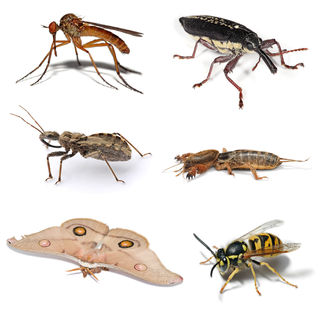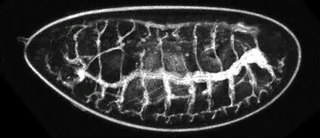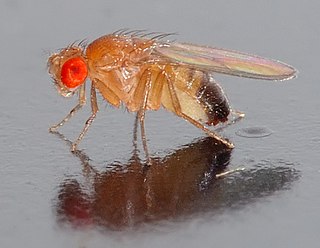
Invertebrates are animals that neither possess nor develop a vertebral column, derived from the notochord. This includes all animals apart from the subphylum Vertebrata. Familiar examples of invertebrates include arthropods, mollusks, annelids, and cnidarians.

An artery is a blood vessel that takes blood away from the heart to all parts of the body. Most arteries carry oxygenated blood; the two exceptions are the pulmonary and the umbilical arteries, which carry deoxygenated blood to the organs that oxygenate it. The effective arterial blood volume is that extracellular fluid which fills the arterial system.

The lungs are the primary organs of the respiratory system in humans and many other animals including a few fish and some snails. In mammals and most other vertebrates, two lungs are located near the backbone on either side of the heart. Their function in the respiratory system is to extract oxygen from the atmosphere and transfer it into the bloodstream, and to release carbon dioxide from the bloodstream into the atmosphere, in a process of gas exchange. Respiration is driven by different muscular systems in different species. Mammals, reptiles and birds use their different muscles to support and foster breathing. In early tetrapods, air was driven into the lungs by the pharyngeal muscles via buccal pumping, a mechanism still seen in amphibians. In humans, the main muscle of respiration that drives breathing is the diaphragm. The lungs also provide airflow that makes vocal sounds including human speech possible.

A gill is a respiratory organ found in many aquatic organisms that extracts dissolved oxygen from water and excretes carbon dioxide. The gills of some species, such as hermit crabs, have adapted to allow respiration on land provided they are kept moist. The microscopic structure of a gill presents a large surface area to the external environment. Branchia is the zoologists' name for gills.

The trachea, colloquially called the windpipe, is a cartilaginous tube that connects the pharynx and larynx to the lungs, allowing the passage of air, and so is present in almost all air-breathing animals with lungs. The trachea extends from the larynx and branches into the two primary bronchi. At the top of the trachea the cricoid cartilage attaches it to the larynx. This is the only complete tracheal ring, the others being incomplete rings of reinforcing cartilage. The trachealis muscle joins the ends of the rings and these are joined vertically by bands of fibrous connective tissue – the annular ligaments of trachea. The epiglottis closes the opening to the larynx during swallowing.

In humans, the respiratory tract is the part of the anatomy of the respiratory system involved with the process of respiration. Air is breathed in through the nose or the mouth. In the nasal cavity, a layer of mucous membrane acts as a filter and traps pollutants and other harmful substances found in the air. Next, air moves into the pharynx, a passage that contains the intersection between the esophagus and the larynx. The opening of the larynx has a special flap of cartilage, the epiglottis, that opens to allow air to pass through but closes to prevent food from moving into the airway.

A bronchus is a passage of airway in the respiratory system that conducts air into the lungs. The first bronchi to branch from the trachea are the right main bronchus and the left main bronchus. These are the widest and enter the lungs at each hilum, where they branch into narrower secondary bronchi known as lobar bronchi, and these branch into narrower tertiary bronchi known as segmental bronchi. Further divisions of the segmental bronchi are known as 4th order, 5th order, and 6th order segmental bronchi, or grouped together as subsegmental bronchi. The bronchi when too narrow to be supported by cartilage are known as bronchioles. No gas exchange takes place in the bronchi.

The bronchioles or bronchioli are the passageways by which air passes through the nose or mouth to the alveoli of the lungs, in which branches no longer contain cartilage or glands in their submucosa. They are branches of the bronchi, and are part of the conducting zone of the respiratory system. The bronchioles divide further into smaller terminal bronchioles which are still in the conducting zone and these then divide into the smaller respiratory bronchioles which mark the beginning of the respiratory region.

Aquatic respiration is the process whereby an aquatic animal obtains oxygen from water.
Gas exchange is the physical process by which gases move passively by diffusion across a surface. For example, this surface might be the air/water interface of a water body, the surface of a gas bubble in a liquid, a gas-permeable membrane, or a biological membrane that forms the boundary between an organism and its extracellular environment.
Taenidia are circumferential thickenings of the cuticle inside a trachea or tracheole in an insect's respiratory system. The geometry of the taenidiae varies across different orders of insects and even throughout the tracheae in an individual organism. Taenidia generally take the form of either hoop or spiral thickenings of the tracheal cuticle.

Insect wings are adult outgrowths of the insect exoskeleton that enable insects to fly. They are found on the second and third thoracic segments, and the two pairs are often referred to as the forewings and hindwings, respectively, though a few insects lack hindwings, even rudiments. The wings are strengthened by a number of longitudinal veins, which often have cross-connections that form closed "cells" in the membrane. The patterns resulting from the fusion and cross-connection of the wing veins are often diagnostic for different evolutionary lineages and can be used for identification to the family or even genus level in many orders of insects.
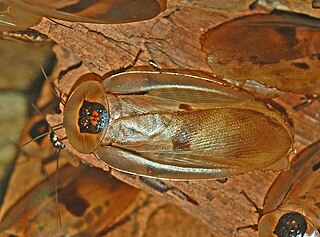
The Central American giant cave cockroach is a cockroach belonging to the family Blaberidae.
Insect physiology includes the physiology and biochemistry of insect organ systems.
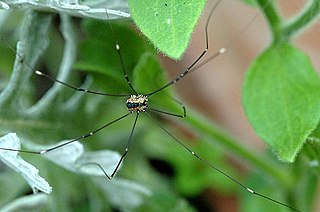
Leiobunum rotundum is a species of harvestman. It is found in the western Old World.

Opiliones are an order of arachnids and share many common characteristics with other arachnids. However, several differences separate harvestmen from other arachnid orders such as spiders. The bodies of opliones are divided into two tagmata : the abdomen (opisthosoma) and the cephalothorax (prosoma). Unlike spiders, the juncture between the abdomen and cephalothorax is often poorly defined. Harvestmen have chelicerae, pedipalps and four pairs of legs. Most harvestmen have two eyes, although there are eyeless species.
Discontinuous gas-exchange cycles (DGC), also called discontinuous ventilation or discontinuous ventilatory cycles, follow one of several patterns of arthropod gas exchange that have been documented primarily in insects; they occur when the insect is at rest. During DGC, oxygen (O2) uptake and carbon dioxide (CO2) release from the whole insect follow a cyclical pattern characterized by periods of little to no release of CO2 to the external environment. Discontinuous gas exchange is traditionally defined in three phases, whose names reflect the behaviour of the spiracles: the closed phase, the flutter phase, and the open phase.

Insect morphology is the study and description of the physical form of insects. The terminology used to describe insects is similar to that used for other arthropods due to their shared evolutionary history. Three physical features separate insects from other arthropods: they have a body divided into three regions, have three pairs of legs, and mouthparts located outside of the head capsule. It is this position of the mouthparts which divides them from their closest relatives, the non-insect hexapods, which includes Protura, Diplura, and Collembola.

